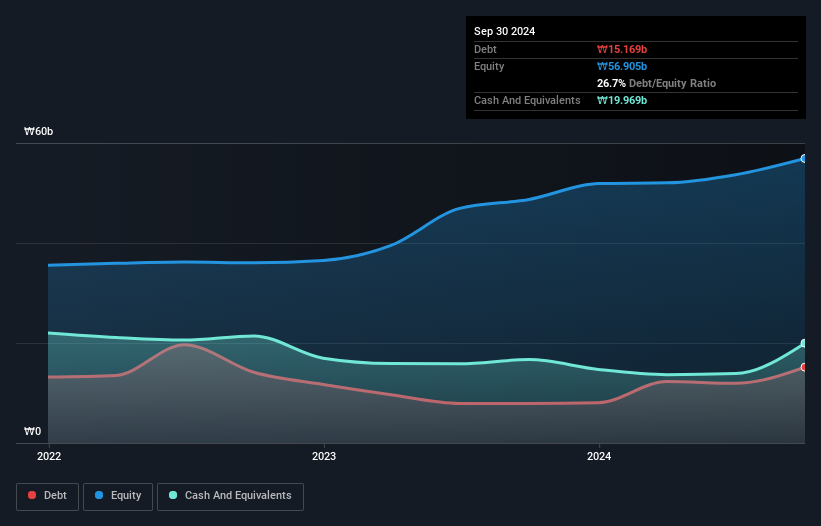- South Korea
- /
- Medical Equipment
- /
- KOSDAQ:A226400
Does OSTEONIC (KOSDAQ:226400) Have A Healthy Balance Sheet?

Legendary fund manager Li Lu (who Charlie Munger backed) once said, 'The biggest investment risk is not the volatility of prices, but whether you will suffer a permanent loss of capital.' It's only natural to consider a company's balance sheet when you examine how risky it is, since debt is often involved when a business collapses. Importantly, OSTEONIC Co., Ltd. (KOSDAQ:226400) does carry debt. But the more important question is: how much risk is that debt creating?
What Risk Does Debt Bring?
Debt assists a business until the business has trouble paying it off, either with new capital or with free cash flow. If things get really bad, the lenders can take control of the business. While that is not too common, we often do see indebted companies permanently diluting shareholders because lenders force them to raise capital at a distressed price. Of course, plenty of companies use debt to fund growth, without any negative consequences. When we think about a company's use of debt, we first look at cash and debt together.
View our latest analysis for OSTEONIC
What Is OSTEONIC's Net Debt?
As you can see below, at the end of September 2024, OSTEONIC had ₩15.2b of debt, up from ₩7.92b a year ago. Click the image for more detail. However, its balance sheet shows it holds ₩20.0b in cash, so it actually has ₩4.80b net cash.

How Healthy Is OSTEONIC's Balance Sheet?
Zooming in on the latest balance sheet data, we can see that OSTEONIC had liabilities of ₩17.5b due within 12 months and liabilities of ₩12.9b due beyond that. Offsetting these obligations, it had cash of ₩20.0b as well as receivables valued at ₩13.2m due within 12 months. So its liabilities outweigh the sum of its cash and (near-term) receivables by ₩10.4b.
Of course, OSTEONIC has a market capitalization of ₩101.8b, so these liabilities are probably manageable. However, we do think it is worth keeping an eye on its balance sheet strength, as it may change over time. Despite its noteworthy liabilities, OSTEONIC boasts net cash, so it's fair to say it does not have a heavy debt load!
In addition to that, we're happy to report that OSTEONIC has boosted its EBIT by 45%, thus reducing the spectre of future debt repayments. When analysing debt levels, the balance sheet is the obvious place to start. But it is OSTEONIC's earnings that will influence how the balance sheet holds up in the future. So if you're keen to discover more about its earnings, it might be worth checking out this graph of its long term earnings trend.
Finally, a company can only pay off debt with cold hard cash, not accounting profits. While OSTEONIC has net cash on its balance sheet, it's still worth taking a look at its ability to convert earnings before interest and tax (EBIT) to free cash flow, to help us understand how quickly it is building (or eroding) that cash balance. During the last three years, OSTEONIC burned a lot of cash. While investors are no doubt expecting a reversal of that situation in due course, it clearly does mean its use of debt is more risky.
Summing Up
While OSTEONIC does have more liabilities than liquid assets, it also has net cash of ₩4.80b. And it impressed us with its EBIT growth of 45% over the last year. So we don't have any problem with OSTEONIC's use of debt. There's no doubt that we learn most about debt from the balance sheet. But ultimately, every company can contain risks that exist outside of the balance sheet. We've identified 2 warning signs with OSTEONIC (at least 1 which is a bit concerning) , and understanding them should be part of your investment process.
If you're interested in investing in businesses that can grow profits without the burden of debt, then check out this free list of growing businesses that have net cash on the balance sheet.
New: AI Stock Screener & Alerts
Our new AI Stock Screener scans the market every day to uncover opportunities.
• Dividend Powerhouses (3%+ Yield)
• Undervalued Small Caps with Insider Buying
• High growth Tech and AI Companies
Or build your own from over 50 metrics.
Have feedback on this article? Concerned about the content? Get in touch with us directly. Alternatively, email editorial-team (at) simplywallst.com.
This article by Simply Wall St is general in nature. We provide commentary based on historical data and analyst forecasts only using an unbiased methodology and our articles are not intended to be financial advice. It does not constitute a recommendation to buy or sell any stock, and does not take account of your objectives, or your financial situation. We aim to bring you long-term focused analysis driven by fundamental data. Note that our analysis may not factor in the latest price-sensitive company announcements or qualitative material. Simply Wall St has no position in any stocks mentioned.
About KOSDAQ:A226400
OSTEONIC
Osteonic Co., Ltd. develops, manufactures, and sells bone fixation systems.
Excellent balance sheet with acceptable track record.
Market Insights
Community Narratives




